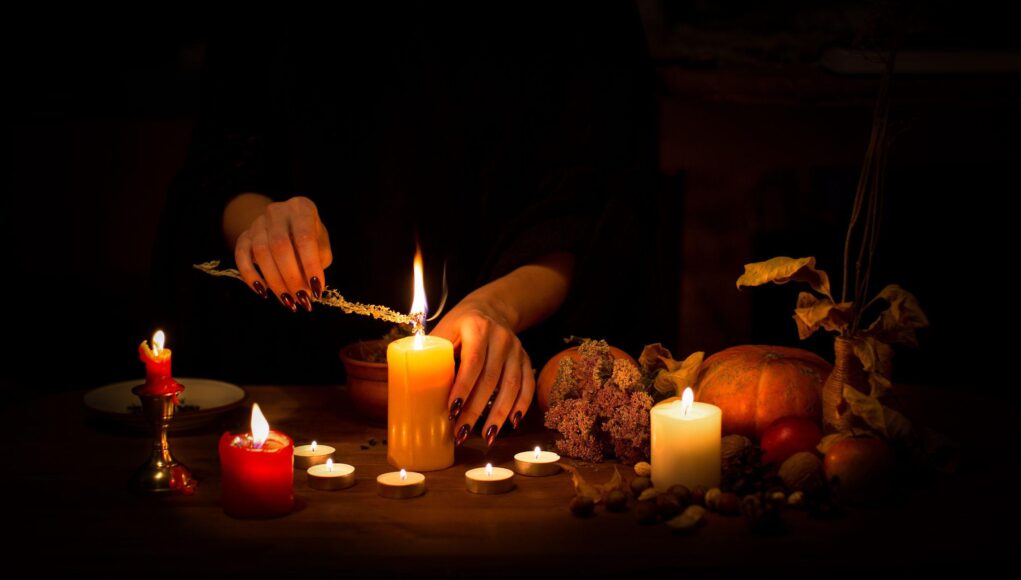Mark your calendar for September 22 and start making plans to celebrate Mabon. Ma-what? Mabon takes place on the fall equinox. It’s a pagan celebration, originating from the ancient Celts, who populated Britain and much of Northwest Europe before the march of the Romans (so we’re going back nearly 2,000 years here). This group of druid-y, tree-lovin’ people celebrated the earth’s cycles and seasons by dividing the year into eight segments at key seasonal turning points, creating eight festivals that are still celebrated today by some Wiccans and pagans.
The exact date of Mabon varies from year to year, but it always falls on the fall equinox. The rest of the eight festivals—sometimes called the “Wheel of the Year”—fall on the spring equinox (Ostara), the summer solstice (Litha), the winter solstice (Yule), and the four midpoints or “cross-quarters” that halfway between a solstice and an equinox (these are called Imbolc, Beltain, Lammas, and Samhain).
Got all that? Okay, good.
Mabon is essentially a harvest festival. Celts and pagans used this day to give thanks to nature or Mother Earth for a good harvest, and to pray to their gods and goddesses that the crop would last throughout the winter. There’d be feasting, fires, offerings, and sacrifices. The usual pagan party.
Today, the fall equinox is a time to get cozy (say hello to pumpkin spice lattes, s’mores, giant cardigans and not going ~out-out~), focus on the home, give thanks for security, and share with others.
In Celtic folklore, the name Mabon (although some historians dispute this) is thought to come from the Welsh god Mabon, who was the son of the Earth Mother Goddess, and a god of light himself. In British folklore, Mabon is associated with Herne the Hunter and the start of deer-hunting season.
Many cultures celebrate some kind of harvest festival near the fall equinox. There’s Oktoberfest in Germany, Mid-Autumn Festival in China, Mehregan in Iran, and even American Thanksgiving was originally on October 3 (much closer to the actual harvest season).
At its core, Mabon is all about gratitude for what has been reaped this year, with an eye to the hardships of winter. It also brings a recognition of a mental and physical adjustment needed for the darker, longer nights and harder conditions ahead. Here are a few ways to celebrate.
Apples are a common symbol of this Mabon, so bring them into your home as fresh fruit, juice or cider, delicious warm pies or pastries, or even scented candles. Apple up!
Any baby pagan or witch knows that making yourself an altar is Magick 101. You can make your altar on your kitchen table, windowsill, dresser, fireplace—wherever you have space.
For Mabon, try adding harvest fruits and vegetables to your altar (like apples, leaves, pinecones, corn, pomegranate, squash, and root vegetables—go ahead, add a pumpkin if you must). Color-wise, you’re looking for gold, orange, red, bronze and rust. And for scents, you’re seeking sage, cinnamon, orange and apple. Crystals in dark colors, particularly in shades of green or brown, will add a good vibration. Make it look welcoming, pretty, and festive.
Light an orange or yellow candle on your altar and give thanks for the security, happiness, and the advantages you have in your life right now. You can do this on September 23 for Mabon, or on every night from the Full Moon on September 20 until the New Moon on October 6.
Like spring, Mabon is a great time to clean up at home. After all, you’re probably going to be spending more time here over fall and winter. Finish any lingering projects and clear out emotional and physical clutter, so that your home feels calm, relaxing, and peaceful.
Do you have a collection of beautiful notebooks you’ve never written in? Get one out and start a gratitude journal. Write down everything that happens that you feel happy about or grateful for. I guarantee this will help brighten your mood. Plus, it signals to the universe that you’d like MORE of the same, please.
Try hosting a Mabon harvest dinner. Get everyone to bring their favorite food or drink, and share with each other. Show off your altar. Start some happy discussions about what you’re grateful for in the past year. Aim to create a warm, cozy, pre-Thanksgiving vibe—but much more relaxed.
Pick a cause or campaign that you feel strongly about, and give them some of your time, energy, or money. Better yet, think of a way you can give ongoing support throughout the whole year.











